Water in engine oil is a problem that can cause serious damage to your engine if left unchecked. Understanding what water in engine oil is, common causes of it, how to diagnose a problem with it and the damage it can cause is essential for maintaining your vehicle. By learning more about this issue and taking preventative measures, you can protect your engine from costly repairs and extend its life.
What Is Water In Engine Oil?
Water in engine oil is caused when liquid water enters the lubrication system of an internal combustion engine. This can occur when condensation or moisture builds up within the system or when coolant leaks into the oil sump due to worn-out seals or gaskets. Water in motor oil can also be introduced during an oil change if moisture contaminated filters are used, or if new oil has been stored improperly allowing contamination by rainwater or other sources of liquid water.
Common Causes Of Water In Engine Oil
-
: One of the most common causes of water entering engine oil is a coolant leak. This can happen when coolant components, such as a coolant hose or radiator, become cracked or damaged due to wear and tear or even extreme temperatures. This type of leak allows coolant to mix with the engine oil, resulting in the presence of water in the oil.
-
Condensation or Moisture Buildup: When an internal combustion engine runs for prolonged periods of time, it produces heat and moisture that can cause condensation to build up on its internal parts as well as in its fluids like oil and coolant. Over time, this buildup can accumulate enough moisture to collect in the engine oil pan and affect its lubricating properties by forming an emulsion with the motor oil, leading to water intrusion. Also you can choose here Best Synthetic Oil for Ford 6.7 Diesel.
-
Worn Out Seals or Gaskets: As rubber seals and gaskets age over time they can begin to wear down and break down completely into small pieces which will then get caught in various parts inside your vehicle’s engine compartment, such as fuel injectors or piston rings etc., eventually leading to a leakage which allows water into your engine’s lubricating system.
-
Other Possible Causes: Other possible causes include leaking head gaskets due to over-filled cooling systems; cracked cylinder heads; worn out freeze plugs; un-flanged bolts around cylinder heads; corroded or damaged radiators; improper mounting of water pumps; cracked block surfaces; faulty thermostats etc., all leading up to leaks allowing water mixed with dirt particles into your car’s lubrication system resulting in too much moisture inside your vehicle’s motor oil container causing overheating and sludge buildup at times leading up to complete failure if left unchecked for too long a period of time.
Symptoms of Water in Engine Oil
Water in engine oil can cause several different symptoms which can vary depending on the amount of water present in the oil. Common signs of water in engine oil include:
-
Excessive Smoke: When there is water in the oil, it will mix with the fuel and cause smoke to be emitted when the engine is running, resulting in a smoky exhaust.
-
Overheating: Water contamination can lead to overheating as it weakens or prevents lubrication, causing metal surfaces to rub and produce friction heat.
-
Poor Engine Performance: As a result of decreased lubrication and increased metal-to-metal contact due to water contamination, an engine may suffer from poor performance due to difficulty starting or lack of power when running.
-
Leaking Oil: Water contamination can also lead to leaking oil due to weakened seals caused by corrosion and break down of rubber washers from continual exposure of water droplets inside an engine’s crankcase system.
-
Low Oil Pressure Gauge Reading: The presence of water will affect an engine’s normal operating temperature as well as its ability to maintain proper lubrication levels; therefore, a decrease in pressure will be seen on an engines gauge when there is too much water present inside its crankcase system causing it not to function properly anymore.
Solutions for the Presence of Water in Motor Oil
Water contamination in motor oil can be a major problem and cause significant damage to the engine. To address this issue, it is important to take preventative measures, such as keeping the motor oil clean and dry, replacing contaminated parts, and flushing the system regularly. Regular maintenance of your vehicle will help ensure that your engine runs properly and is less prone to water-related problems. When left unchecked, water in motor oil can cause rusting of components, poor lubrication which leads to premature wear on internal components and reduced fuel economy. Taking steps to keep your motor oil clean and dry is essential for the performance of any engine.
-
Preventative Measures: Keeping the motor oil clean and dry is critical for avoiding water contamination. It is important to inspect your vehicle regularly for signs of leaks or other changes that may indicate a potential problem with water infiltration into the engine components. Additionally, you should use quality filters when changing your motor oil which are designed to trap moisture before it reaches the engine components.
-
Replacing Contaminated Parts: If any part of your vehicle has been exposed to excessive amounts of water then it should be replaced immediately as it could lead to further damage if left unchecked. Some parts that may need replacing include spark plugs, fuel injectors, sensors, seals or gaskets which are all susceptible to damage from prolonged exposure from water infiltration in motor oil.
-
Flushing Your System: In some cases where there has been extensive contact with standing water or flooding conditions it may be necessary to flush out all contaminants prior to refilling with new clean oil. This requires draining out all existing fluid before replenishing with fresh fluid which should also have a higher level of anti-corrosion additives than normal oils used in everyday use conditions.
| Cause | Fixing |
| Coolant Leaks | Replace cracked coolant components and check for other leaks. |
| Condensation or Moisture Buildup | Regularly maintain your vehicle to prevent accumulation of moisture. |
| Worn Out Seals or Gaskets | Replace worn out seals or gaskets to prevent leakage into the oil sump. |
| Other Possible Causes | Identify potential sources of water intrusion and address them accordingly. |
Conclusion
Water contamination in motor oil can cause serious damage if not addressed promptly so preventive measures must be taken on a regular basis such as keeping the motor oil clean and dry by using quality filters when changing on schedule, replacing any contaminated parts immediately, and flushing out all contaminants prior when necessary. Taking these steps will ensure that problems related with water infiltration into an engine will not arise while also keeping its performance optimally running at peak levels.





 : One of the most common causes of water entering engine oil is a coolant leak. This can happen when coolant components, such as a coolant hose or radiator, become cracked or damaged due to wear and tear or even extreme temperatures. This type of leak allows coolant to mix with the engine oil, resulting in the presence of water in the oil.
: One of the most common causes of water entering engine oil is a coolant leak. This can happen when coolant components, such as a coolant hose or radiator, become cracked or damaged due to wear and tear or even extreme temperatures. This type of leak allows coolant to mix with the engine oil, resulting in the presence of water in the oil. Preventative Measures: Keeping the motor oil clean and dry is critical for avoiding water contamination. It is important to inspect your vehicle regularly for signs of leaks or other changes that may indicate a potential problem with water infiltration into the engine components. Additionally, you should use quality filters when changing your motor oil which are designed to trap moisture before it reaches the engine components.
Preventative Measures: Keeping the motor oil clean and dry is critical for avoiding water contamination. It is important to inspect your vehicle regularly for signs of leaks or other changes that may indicate a potential problem with water infiltration into the engine components. Additionally, you should use quality filters when changing your motor oil which are designed to trap moisture before it reaches the engine components.
Add Comment